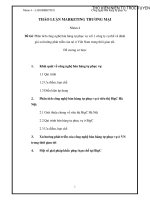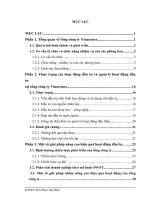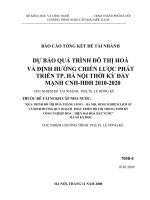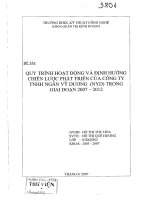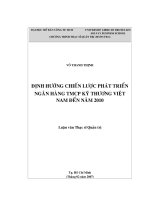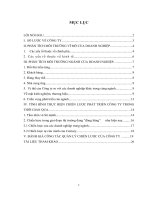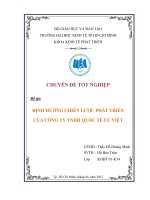Phân tích SWOT và định hướng chiến lược phát triển của hãng hàng không vietnam trong thời gian tới e
Bạn đang xem bản rút gọn của tài liệu. Xem và tải ngay bản đầy đủ của tài liệu tại đây (107.01 KB, 17 trang )
PHÂN TÍCH SWOT VÀ ĐỊNH HƯỚNG CHIẾN LƯỢC PHÁT
TRIỂN CỦA HÃNG HÀNG KHÔNG VIETNAM TRONG THỜI GIAN
TỚI
TABLE OF CONTENT:
1. INTRODUCTION ABOUT VIETNAM AIRLINES
2. STATUS OF THIS ENTERPRISE
3. ANALYZE ENVIRONMENTAL FACTORS WHICH AFFECT VIETNAM
AIRLINES
3.1. COMMON ENVIRONMENT – MODEL OF PEST
3.2. CHARACTERISTICS OF THE SECTOR IN CURRENT BUSINESS CONTEXT
3.2.1. Directly affecting environment
3.2.2. Indirectly affecting environment
3.2.3. Direct competitors
3.2.4. Replacing products
3.2.5. Developing trend of Vietnam Airlines in the next years
4. CONCLUSION
1. INTRODUCTION ABOUT VIETNAM AIRLINES
Vietnam National Airlines which has the head quarter in 200 Nguyen Son street, Long Bien
district, Hanoi, Vietnam (English transaction name is Vietnam Airlines) is the national
airlines of the Socialist Republic of Vietnam and is a core element of Vietnam Airlines
Corporation. It is managed by an Assembly including 7 members who are nominated by the
Prime Minister. It has routes in South East Asia, Eastern Asia, Europe, and Oceania with 46
destinations in 19 countries. Its head quarter is put in the two largest airports of Vietnam
that is Noi Bai National Airport and Tan Son Nhat National Airport.
1
Vietnam Airlines is the biggest shareholder with the share of 69.93% of Jetstar Pacific
Airlines. It holds 49% of Cambodia Angkor Air, Cambodia National Airlines and 100% of
VASCO – a small carrier in the South of Vietnam.
It is appreciated as 3-star following standard of Skytrax. On June 10 th, 2010, the carrier
officially joined in Sky Team and became the first carrier of South East Asia which join in
this alliance.
Until the end of 2011, the Corporation accounted for about 80% of share of Vietnam’s
domestic aviation market and about 40% of travelers who are inbound and outbound from
Vietnam.
The main business sector of Vietnam Airlines Corporation
- Air transportation for passengers, luggage, goods, mail, parcels, letters, general aviation,
flight service of political, economic, social, security and defense;
- Repair and maintenance of aircraft, engines, accessories, avionics equipment and other
technical equipment, production of parts and supplies, aircraft parts, equipment and
techniques in the field of aviation industry or providing technical services for domestic
airlines and foreign import and export of aircraft, engines, spare parts, aviation equipment
(rent, lease, hire purchase, purchase and sale) in accordance with State’s regulations.
Industry directly related to service of the main business sector:
- Multimodal Transport; provision of technical services for the commercial land services,
services in the passenger terminal, cargo terminal and apron services at the airport, the
airport; freight forwarding services, production, processing, import and export of food to
serve on aircraft.
- Investment and exploitation of infrastructure at the airport: Terminal passengers, cargo,
technical infrastructure, equipment and service lines and air transport services in
synchronous line air transport;
- Export, import and supply of gasoline, oil, grease aviation, special fluids and other
petroleum at the airport and airport locations;
2
- Agent services for airlines, aircraft manufacturers, engine, equipment, aircraft spare parts,
transport companies and tourism in foreign countries or providing commercial services,
tourism, hotels, tax-free sales at airports, provinces, cities, and other aviation services.
3
- Chart of the organization: ORGANIZATION OF VIETNAM AIRLINES CORPORATION (under 04-CP)
BOARD OF DIRECTORS
Board of innovation
General Department
GENERAL DIRECTOR
Board of Supervisors
Deputy General Directors
Officer Organization
Science & Technology
Office - External Relations
Planning & Investment
Finance & Accountancy
Safety - Security
Trainning Department
Party Committee
Quality Assurance
The Youth Union
The Council:
- Council of fleet expansion
- Council of emergency executives
- Council of Science
- Council ...
Statistics and Informatics
TRADING
EXPLOITATION
TECHNOLOGY
SERVICES AND GROUND EXPLOITATION
Flying Administration
Cargo
Marketing Passengers
Technology
Market service
Factory of commercial ground, NB
Flight Team 919
Market
Northern Regional Office
Material Management
NB Supervisory Center
Factory of commercial ground, DN
Flight attendants
Branches &
Transaction offices in
domestic and overseas
countries
Central Regional Office
TSN Supervisory Center
Factory of commercial ground, TSN
Flight training center
The independent accounting firm and the equity shares of
the Corporation Vietnam Airlines:
- Petroleum Aviation Company
- In Aviation Joint Stock Company
- Export Joint Stock Company, Aviation
- Company shares Aviation Services at Noi Bai airport
- Company shares Aviation Services Danang airport
- Plastic Joint Stock Company senior aviation
- Consultant Joint Stock Company Design Airline Survey
- Construction Joint Stock Company, Aviation
- Company shares Automotive Aviation Transport
- Catering Company shares Noi Bai (NSC)
- Company shares Noi Bai Cargo Services
Southern Regional Office
Department of PM - CI
Air Service Company
Air Science Institute
Factory of aircraft A35
Factory of aircraft A76
The Joint Venture company:
- Distribution Abacus VN Company JV (Abacus)
- Manufacturing meal on the plane company JV (VAC)
- HARDWARE TSN Cargo Services Company JV (TCS)
- HARDWARE freight Company JV(VINACO)
4
2. STATUS OF THIS ENTERPRISE
Domestic route network of Vietnam Airline is designed from the center in the 3 largest
cities of 3 regions such as Hanoi, Da Nang, and Ho Chi Minh to the local areas. Until June,
2004, there are 24 routes to 18 cities and towns across the country, including the north-south
route connecting 03 cities such as Hanoi – Danang - Ho Chi Minh City, accounting for more
than 65% of the total volume of operators as well as domestic transportation. Currently, the
exploitation of these routes north-south is undertaken by Vietnam Airlines. From the second
quarter of 2004, the Vietnam Service Flight Company (Vasco-a member of the Vietnam
Airlines Corporation) has launched flights from Ho Chi Minh City to 2 points as Ca Mau and
Con Dao. The airport system are assigned throughout the region, the potential tourism diverse
network of domestic flights Vietnam Airlines has been uneven development, meet two basic
objectives: Meeting the needs of traveling by road domestic airline serving economic
development - the social, local, especially the remote areas and mountainous island, and
ensuring competitiveness in the international market of airlines VN. However, the economic
effects of the current domestic routes is heterogeneous, some efficient routes with highfrequency exploitation such as the North-South route, fly to Hue, Nha Trang (Cam Ranh),
Phu Quoc, a factor of 85% using the chair, while most of the remaining routes, especially
routes to the underdeveloped economic areas and balance to offset losses from other routes. If
the aviation exploits routes with the short and inefficient distance, it is a market and strength
for of other transport sectors to meet the needs of passengers.
Until June, 2004, network of Vietnam Airlines’ international flights consisted of 40 routes
(37 direct flights and 3 joint venture route (code-sharing) from 03 major cities (Hanoi, Da
Nang, Ho Chi Minh City) to 25 cities around the world, including 11 points in North-East
Asia, 07 points in Southeast Asia,, 02 points in Australia, in Europe 03 points, and 02 points
in North America. For the international aviation market of Vietnam, Northeast Asian markets
including Japan, Korea, Taiwan, Hong Kong and China hold a significant role, with an
average growth rate of 12% per year from 1998 to 2003. In 2003, the Northeast Asian market
accounted for 50% of total international passenger market with over 2 million customers, over
60% of total commodity markets with over 90 thousand tons. Southeast Asia, including the
ASEAN’s countries, the traditional market reached the 2 nd position with nearly 1.3 million
5
visitors accounted for 31.8% of market share, nearly 28 thousand tons of goods accounted for
over 20% market share (in 2003)
About the north-south route, it exploits with high frequency on routes connecting the
centers of economy, politics and culture of the country such as Hanoi - Da Nang - Ho Chi
Minh City, to expand exploitation of inter-regions between Hanoi and Ho Chi Minh City to
Hai Phong, Son La, Quang Ninh, Lao Cai (Northern region), Vinh and Dong Hoi (Zone 4 and
North Central Zone), Da Nang, Hue, Chu Lai (Central), Cam Ranh (South Central); Buon Ma
Thuot, Lien Khuong (Highlands); Phu Quoc, Can Tho (economic zones, tourism key).
+ Increase the supply frequency and load on the local routes.
+ In 2008-2010 these routes open internal area’s routes and new inter-regions such as Ho
Chi Minh City - Chu Lai - Ha Noi, Ha Noi - Da Nang - Quy Nhon and Can Tho - Danang Hanoi Hanoi - Buon Ma Thuot, and Ho Chi Minh City - Dong Hoi - Hanoi, Hue - Da Lat;
increase flight frequency on the route of Hanoi - Da Lat.
The period of 2010-2015, it opens more inter-regional routes from Ho Chi Minh City – Na
San, from Ha Noi - Da Nang - Phu Quoc, researches exploitation of the inter-area routes
which are not connected to Hanoi, Ho Chi Minh City and Da Nang between the tourist
centers such as Hai Phong, Vinh, Dong Hoi, Hue, Cam Ranh, Lien Khuong, Buon Me Thuot,
Can Tho, Phu Quoc ...
3. ANALYZE
ENVIRONMENTAL FACTORS
WHICH AFFECT VIETNAM
AIRLINES
3.1. COMMON ENVIRONMENT – MODEL OF PEST
6
Model of Pest
Politics,
Law
Economy
Society
Technology
In economic globalization background, with multilateral and diversification of
international relationship, our nation has favorable opportunities to acquire knowledge of
science, technology, resources and foreign advanced management experiences to strengthen
aviation potential, satisfy requirement of economic-social development.
To exploit achievement of science and technology revolution, with technology transfer
manners, our nation can directly reach modern technology to shortening process of
technologicalization and modernization and economic development gap in comparison with
the other nations. With knowledge potential, if Vietnam has a right developing strategy of
human resource, we can achieve some aspects of knowledge economic early.
Renovation process has created some new premises for development of our aviation industry
in the coming times. Our economy has high developing speed, favorable political-social
environment. It is deemed to be one of our advantages in trend of regional and global
competition. In context of aggressive and unforeseeable development in quantity, quality and
developing trend of international aviation, capability of opportunity grasp and external
resources exploitation depends on capacity and absorption capability of Vietnam Aviation.
The largest challenge is the appearance of low price air route and airlines, and an addition of
bilateral “resource market” between nations, in condition that our nation is still rich, tight
7
investment capital, long distance of economic, science and technology in comparison with
many nations in region and in the world, it is really a difficulty in the coming times.
In process of economic integration in aviation, Vietnam has faced up with difficulties of
conversion and construction of new economic institutions, commerce, banking finance and
intellectual property…in conformity with international general rule. If we can’t overcome this
condition soon, it will be a barrier for the success of regional and international integration
process.
As above challenges and opportunities, if we do not have breakthrough policies and strong
methods to develop aviation industry, our danger of lag behind economically is likely more
and more and some influences are unavoidable.
Politics and legislation in aviation development
-
To complete legislation document system, to integrate with constantly administrative
reform, management renovation, to manage in trend of strengthen, concentrate on state
supervision and management in operations of civil aviation, especially in security
-
assurance and aviation safety.
To create fair trading environment, to force fair competition between airlines, corporates
-
that takes part in aviation operations.
To arrange, renovate, develop and increase effectives of corporates. To encourage the
foundation of new airlines based on market demand and to take part in aviation services of
-
all corporates of different economic sectors.
To strengthen and foster international integration and competition. To make a general
-
policy, to cooperate with development of Aviation and Tourism.
To invest and develop in main points of aviation locally, especially to develop flight
operations and to invest in infrastructure at airports in island regions, Western Highlands,
Nothern West, Southern West, regions that have tourism development potential, assure to
-
take large aircrafts all night and day.
To take priority in development of aviation industry. To exploit effectively main points of
science and technology applied research in order to serve for aviation development, to
construct information infrastructure, software technology, system network, development
investment should integrate with environment protection.
8
-
To gather all resources, to take priority in fleet, airport infrastructure (especially important
role airports such as Noi Bai, Tan Son Nhat, Long Thanh, Chu Lai) in order to create
drastic, fundamental changes in competence, service quality of the industry in the coming
years.
3.2. CHARACTERISTICS OF THE SECTOR IN CURRENT BUSINESS CONTEXT
Elements that influence to corporates
COMPETITIVE FORCES
(MICHAEL E. PORTER, 1980S)
Potential
competitor
s
Threat of
new
competitors
Power of
Suppliers
Suppliers
Current competitors
Customers
Power of
customers
Threat of
replacing
goods
Replacing
goods
3.2.1. Directly affecting environment
Direct affected environment includes elements that have direct reciprocal influence on
aviation operations, including:
9
-
Consumer: Potential passengers, potential shop owner – persons who have demand of
travelling or transportation by air. In a point of view of a famous expert regarding to Peter
-
Drucker’s managing opinion, the real unique target of a corporate is customer.
Competitors: Regarding to market mechanism and the theory “Open skies”, competition
between airlines and different public transportation are more and more cutthroat. Leaders
of an airline understand that if requirements of customers are not satisfied effectively as
-
well as competitors do, the airline is no longer viable stably.
Suppliers: Regarding to view of system access, air transportation – is the mechanism that
transfer output to input. For general manufacturing and trading type, the main input
includes: Materials, equipment, energy, capital of labor source. For air transportation, it
also includes complex air services, including airport services, air traffic services and
-
services in complex air technology line.
Legislation and the State authorities: In legal documents of international aviation
management, the main notice is the Government Agreement on aviation (bilateral and
multilateral). These agreements are the legal basics to deploy international air
transportation activities, regulations of rights of airlines that take part in market
exploitation and these conditions (supplying transportation, frequency, applied
transportation price…)
3.2.2. Indirectly affecting environment
-
Indirect affected environment of an airline is more complicated than direct affected
environment. We have to imagine about this environment without full information. The
important elements of indirect affected environment are:
-
Technology: Technology is internal and also external element of aviation, aviation
technology renovation has affected on efficiency of air services, invisible attrition speed
(technological backward). Aviation is economical-technical industry that has high level of
science and technology, we should continuously renovate technology by transfer and grasp
-
modern technology.
Economic status: World economic status has impacted on price of human resource and
travelling demand by air (purchasing power of people). Economic status has also impacted
on capital mobilization capability of other airlines, as the State usually against economic
depression by tax regulation, cash volume and banking interest.
10
-
Cultural and political factors: A high international industry like aviation is not affected by
cultural, social factors, social value, traditional culture….traditional culture has a special
impact on marketing and services, such as traditional food, diet …
3.2.3. Direct competitors
Vietnam has now 03 transportation airlines: Vietnam Airlines, Jetstar Pacific Airlines and
Vietjet Air.
Jetstar Pacific Airlines: is the first low price airlines in Vietnam, officially joined in
global Jetstar system since May 2008. With the effort to offer low price for customer every
day, Jetstar has a mission to help people flying more constantly, at the same time to create
more tourism opportunities by air for unaffordable people in the past.
At present, Pacific has exploited 240 flights per week, connecting to cities, well-known
sightseeings in Vietnam such as: Ho Chi Minh city, Ha Noi, Da Nang, Buon Ma Thuot, Vinh,
Nha Trang and Hai Phong
From Jan 01st, 2013, Jetstar Pacific has fully exploited new fleet Airbus 320 (05
aircrafts).
Orientation of shareholders keeps on constructing and developing Jetstar Pacific become
the leading low price airlines in Vietnam and in region. The fleet will be increased by 15
Airbus 320 in the coming years. The participation of Jetstar into global system helps all the
customers connecting to flights and air route of Jetstar Pacific in 16 nations and 60 markets in
Asia – Pacific.
Two main shareholders of Jetstar Pacific are Vietnam Airlines and Australia Airlines –
Quantas Corporation with the shareholding are 66,93% and 30%, respectively. The main
shareholders are from Vietnam such as Saigon Tourist Corporation.
General Director of Jetstar Pacific is Mr. Le Hong Ha and Mr. Duong Tri Thanh is
Chairman of Board of Management.
Vietjet Air: The registered capital is 600 million Vietnam dong (equivalent to 37.5
million US dollar), Vietjet Air is totally owned by Vietnam company, the shareholders are
T&C Holding Corporation, Sovico Corporation and HD Bank.
11
At the end of April 2009, Sovico Holding bought all shareholdings of T&C Holding
Corporation and has begun the biggest shareholders.
In February, 2010, Air Asia bought 30% shareholdings of Vietjet Air. The business of Air
Asia is passenger and baggage transportation and other air logistic services.
At the beginning, after expanding to other destinations in Vietnam, Vietjet Air will start
with domestic flight such as Ha Noi – Ho Chi Minh city and Ha Noi – Da Nang and vice
versa. For the long term, the airlines will exploit international flight to Hong Kong, provinces
in the South of China, Korea and Japan.
However, although Vietjet Air is licensed till the end of 2007, this airlines has not yet
started any routine.
In June 2010, Vietjet Air informed to delay all boarding time until October 2010. The
reason is the airlines need time to handle with arising problems related to shareholdings,
trademark, human resources and fleet…
In the beginning of December 2010, the airlines submitted official document to Civil
Aviation Authority of Vietnam to report financial situation, preparation and at the same time
to ask for delay in undefined time with the reason of trademark disputation.
3.2.4. Replacing products
Domestic substituted products are: railway and waterway
To cope with the continuous development of national economic and the renovation of
transportation market, Vietnam Railway has managed passenger transportation by railway.
For passenger transportation, Vietnam Railway has managed two transportation companies
which have the headquarters in Hanoi and Ho Chi Minh city, these companies operate not
only in domestic passenger transportation but also in international. Regarding to passenger
transportation service, Vietnam Railway has successfully managed and cooperated with
investors in some aspects such as:
- Product and supply fast food and bottle water for passenger.
- Provide suitable services for passenger such as trolley luggage, plastic cups, bring ticket
to home…
12
- Develop ticketing system to passenger through internet and agent.
- Supply many different types of class (soft seat with air-conditioning system, hard
sleeper with air-conditioning system, soft sleeper with air-conditioning system) and other
service to passenger.
- Provide information to passenger through website of Viet Nam railways such as time,
fare, schedules…
- Repair and improve interior of wagon for the running train continuously.
- Supply rail-TV service on North- South express train.
Besides the transportation business, VN railway management and operation of longer trains
for the purpose of community service is not profitable, Vietnamese railway manages and
operates the trains to service the community without profit. Viet Nam Railways continuously
improve service quality to meet customer needs and create a visible change in the passenger
transportation business, which is evidenced by the growth of the volume for transport.
Revenue from transport has grown 10-15% annually.
Currently, Vietnam has a total of 114 ports. The major ports are concentrated in Saigon, Hai
Phong and Quang Ninh. These ports are responsible for over 60% of goods that are
transported by sea of country. Vietnam Transportation of goods by sea Vietnam has
continuously increased over the last decade. This achievement is not commensurate with the
potential of the shipping industry in our country. Shipping industry in Vietnam has not
developed remarkably in area. In the 5 years from 2001 to 2005, Vietnam's fleet has increased
by 366 vessels with a tonnage of 1,269. 001T, increasing of 50.97% in quantity and 68.72% in
terms of tonnage. By 2010 the total fleet tonnage is 3,040,374 DWT Vietnam and 2020 will
be 4.71118 million DWT. In total, Vietnam Maritime Company (VINALINES) is the largest
marine transportation that accounted for 60% of the country. VINALINES fleet of 151 units
with a total tonnage of 2.68 million DWT, ranked 87 in the world. Currently, Vietnam has
about 1,600 vessels, tonnage of 6.2 million tons, ranking 31st in the world.
3.2.5. Developing trend of Vietnam Airlines in the next years
The solutions of human resource development
13
+ Method and form of training diversification: short and long time, training in country or
other countries, training at school and self – training. Making use of maximize ability and
capacity in the country, particularly for open sector.
+ Recruiting through public examinations probationary on strict criteria system, science and
equal to everybody. Priority use of human resources and performance incentives with labor
beneficiary at regional and remote areas, islands.
The solutions of raising funds
+ Nation priority use of national budget for infrastructure development of air traffic. Budget
supply for plan groups, develop air business, services… mobilized from businesses,
organizations and individuals.
+ Beneficiary use infrastructure of air traffic directly through ticketing fare, SB fee, Surcharge
through airline petroleum price.
+ Promote the mobilization of funds from businesses, economic organizations, individuals
from the form of joint stock, stock issuance, project bonds serving for building of plan
groups, expand business production.
+ Investment form diversification, encouraging project combine to fund which invest in
country for all economic sectors, expand foreign investment directly from many different
forms, encourage foreign investment directly (FDI), for the development of Chu Lai, Long
Thanh Airlines, new airport, development of airline business( repair, aircraft maintenance,
manufacture of components, material, equipment….), basis of other technical facilities at
airport.
+ Lists are announced widely, long-term investment program to 2015, including foreign
investment directly, fund support official development to orient for investor in county and
other countries.
airline network is built base on “Axis – spokes “ model with high frequency extraction, with
good transit service at 2 centers are Ha Noi and Ho Chi Minh. In flight paths of Viet Nam
airline, Southeast Asia and Northeast Asia are main international flight paths; The domestic
14
and Indochina are important flight paths and the transcontinental route has long term strategy
meaning.
- The North Asia airline network
+ Expand to Japan, South Korea, China, Taiwan and Hong Kong by large bodied aircraft and
increased flight frequency and flight point. To 2020 will be connect to international airport
with 4 points of Japan (Tokyo, Osaka, Fukuka, Nagoya), 7 points of China (Beijing,
Shanghai, Kunming, Guangzhou, Nanning, Shenzhen, Hainan island, 2 points of Taiwan
(Taipei, Kaohsiung), 1 points of Hong Kong, 2 points of South Korea (Seoul, Jeju, Pusan).
+ Attach special importance to business right 3-4 connect to business right 6 between
Northeast Asia with Southeast Asia and Australia. Expand to exchange business right with
North Asia Counties.
- The Southeast Asia airline network
To excute transportation liberalization (including business right No.5 in ASEAN). To 2020,
the Southeast Asia airlines networks are as follows:
+ Fight paths in sub-region of Viet Nam – Laos – Cambodia – Myanmar: keep to compete
with Bangkok, increase flight frequency between Vietnam (Ha Noi and Ho Chi Minh city)
with Cambodia (Phnom Penh and Siem Reap), transcontinental route Indochina, Hue – Siem
Reap - Luangprabang flight path, open flight from Ha Noi and Ho Chi Minh city to Jang-geun
(Myanmar), from Da Nang to Vientiane. Strengthening exploit business right 6 to assist long
flight of Viet Nam airlines.
+ Strengthening frequency of high flight exploitation from Ho Chi Minh City and Ha Noi to
Bangkok, Kuala Lampur; and open flight to there. With flights 2 times per day can connect
with larger bodied aircraft to raise effective. It researches to open routing flight between Ha
Noi, Ho Chi Minh with Thailand and Malaysia. Open Ho Chi Minh – Jakarta and Ha Noi –
Jakarta flights connect to business right 5 at other places at Southeast Asia. Open again Ho
Chi Minh – Manila flight.
+ To encourage open international routes directly between Hai Phong, Hue, Nha Trang, Can
Tho, Phu Quoc with countries in the region.
15
The South Asia, the South Pacific and the Middle East airline network:
Strengthening frequency by larger bodied aircraft to Australia (Melbourne, Sydney); open
flight to India, the 3rd in Australia, open flight New Zealand through business right 5 at The
Southeast Asia. Open routing flight to 1-2 points at Middle East (UAE, Qatar).
- Far airline network:
+ Strengthening direct flights from Ha Noi, Ho Chi Minh to Paris, Moscow and Franfurt;
research to other larger center transit at Europe (London, Amsterdam…). And open flights to
Switzerland, Vienna, Ukraina, Scantonavi… and the Russian Far East, North America (the
last point in the U.S., Canada), Middle East, Africa and South America.
+ Early open flight to United States, combine exploitation with business right No.5 in
Northeast Asia or Europe.
4. CONCLUSION
Vietnam airline market is an incomplete competition, the competitions trend to more and
more strictly among air transportation business and other ones not only in the domestic airline
market but also in the international airline market.
In the development of domestic and international airline market come up more and more
vibrantly and complexly. The state manage with the airline field is an important factor to
secure to take this operation to the legal framework and to bring the benefit nation. Policies
define market, restrict price competition and encourage competition outside the domestic
market to ensure that the airline business have easy environment to development, connect
with each other and other transportations to create public and diverse transportation in
country. To regulate bilateral in international transportations to help air transport business that
do not exist and develop in conditional competition.
To develop Viet Nam airline, we need to build a fair business environment, encouraging
promote competition, to ensure investment and business opportunities; mechanism,
preferential policies for the sector, product and priority service or to encourage the
development; investment in human resource development, complete structure of human
resources in the sector, satisfy management requirements, product international standard and
16
rule; effective implementation of scientific achievements and program of scientific and
technological applications for development of the airline industry. In the longer term policies
have to been performed synchronously: completing legal documents and reforming
administrative, to create adequate legal framework, fully consistent with the requirements of
international integration country, checking, adjusting and supplying the approved plans,
building unapproved plans, to suit the new situation and to meet the development
requirements, creating favorable conditions for implementing long-term investment projects,
actively integrating with the world economy, along with the process to remove withdrawal of
the protection of the State in the process of competing businesses in the international market.
Developing the aviation market in the open direction, linking
aviation market in the region and the world; arranged restructuring the organization and
management of the sector, improving the efficiency of business in the form of shares
chemistry; Expanding forms of cooperation, joint ventures with foreign partners; Building
and strengthening the infrastructure of the port system air, investing the equipments and
modern techniques to ensure the requirements of development,; investing and upgrading of
Aviation Institute with a functional training Basic training at the undergraduate, postgraduate
and research and application of new aviation technology; Promoting brand, expanding
markets and foreign operators, continuously improving service quality, step by step and
improve Vietnam aviation image in the international arena.
17

